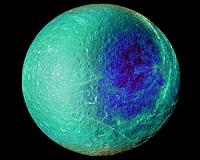 |
Pasadena CA (JPL) Jan 27, 2011 For years researchers have been debating whether Enceladus, a tiny moon floating just outside Saturn's rings, is home to a vast underground ocean. Is it wet--or not? Now, new evidence is tipping the scales. Not only does Enceladus likely have an ocean, that ocean is probably fizzy like a soft drink and could be friendly to microbial life. The story begins in 2005 when NASA's Cassini probe flew past Enceladus for a close encounter. "Geophysicists expected this little world to be a lump of ice, cold, dead, and uninteresting," says Dennis Matson of NASA's Jet Propulsion Laboratory. "Boy, were we surprised!" Cassini found the little moon busily puffing plumes of water vapor, icy particles, and organic compounds out through fissures (now known as "tiger stripes") in its frozen carapace. Mimas, a nearby moon about the same size, was as dead as researchers expected, but Enceladus was precociously active. Many researchers viewed the icy jets as proof of a large subterranean body of water. Near-surface pockets of liquid water with temperatures near 32o F could explain the watery plumes. But there were problems with this theory. For one thing, where was the salt? In initial flybys, Cassini's instruments detected carbon, hydrogen, oxygen, nitrogen, and various hydrocarbons in the plume gasses. But there were none of the elements of salt that ocean water should contain. In 2009 Cassini's cosmic dust analyzer located the missing salt - in a surprising place. "It wasn't in the plume gasses where we'd been looking for it," says Matson. "Instead, sodium and potassium salts and carbonates were locked up in the plumes' icy particles.* And the source of these substances has to be an ocean. Stuff dissolved in an ocean is similar to the contents of these grains." The latest Cassini observations presented another intriguing discovery: thermal measurements revealed fissures with temperatures as high as -120o Fahrenheit (190 Kelvin). "This discovery resets our clocks!" says Matson. "Temperatures this high have to be volcanic in origin. Heat must be flowing from the interior, enough to melt some of the underground ice, creating an underground waterworks." The finding has led the scientists to ponder how contents of an ocean capped by a crust of ice as much as tens of miles thick could reach the surface. "Have you ever been sprayed when you popped the top of a soda can?" asks Matson. The model he and his colleagues propose suggests that gasses dissolved in water deep below the surface form bubbles. Since the density of the resulting "sparkling water" is less than that of the ice, the liquid ascends quickly up through the ice to the surface.** "Most of the water spreads out sideways and 'warms' a thin surface ice lid, which is about 300 feet thick," explains Matson. "But some of it collects in subsurface chambers, builds up pressure, and then blasts out through small holes in the ground, like soda spewing out of that can you opened. As the remaining water cools, it percolates back down to replenish the ocean and start the process all over again." Another mystery remains: "Where's the heat coming from on this tiny body?" wonders Larry Esposito of the University of Colorado. "We think tidal heating could be contributing." Saturn's powerful tides actually cause the shape of Enceladus to change slightly as it orbits. Flexing motions in the moon's interior generate heat--like the heat you feel in a paperclip when you rapidly bend it back and forth. In this model, internal friction powers volcanic activity, which warms and melts the ice. "It's clear now that, whatever is producing the heat, Enceladus meets many requirements for life," says Esposito. "We know it has a liquid ocean, organics, and an energy source. And to top it off, we know of organisms on Earth in similar environments." No one knows for sure what's going on under the ice, but it seems this little moon has quite a story to tell: erupting jets, an underground ocean, the possibility for life. And they thought this place was dull.
Share This Article With Planet Earth
Related Links Cassini-Huygens mission Explore The Ring World of Saturn and her moons Jupiter and its Moons The million outer planets of a star called Sol News Flash at Mercury
 New Images Indicate Tectonic Activity On Rhea
New Images Indicate Tectonic Activity On RheaMoffett Field CA (SPX) Jan 06, 2011 Newly released images of Saturn's second largest moon Rhea obtained by NASA's Cassini spacecraft show dramatic views of fractures cutting through craters on the moon's surface, revealing a history of tectonic rumbling. The images are among the highest-resolution views ever obtained of Rhea. "These recent, high-resolution Cassini images help us put Saturn's moon in the context of the moons' ... read more |
|
| The content herein, unless otherwise known to be public domain, are Copyright 1995-2010 - SpaceDaily. AFP and UPI Wire Stories are copyright Agence France-Presse and United Press International. ESA Portal Reports are copyright European Space Agency. All NASA sourced material is public domain. Additional copyrights may apply in whole or part to other bona fide parties. Advertising does not imply endorsement,agreement or approval of any opinions, statements or information provided by SpaceDaily on any Web page published or hosted by SpaceDaily. Privacy Statement |